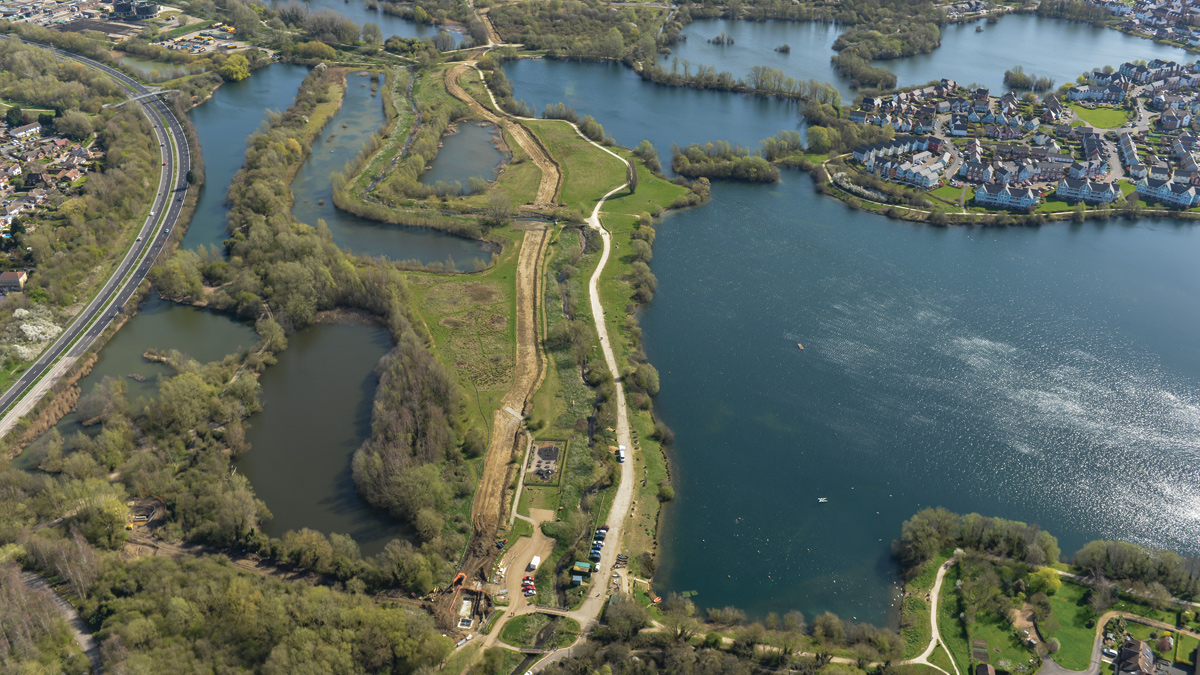Burham Strategic Water Main (2016)

Aerial photo pipeline route through Leybourne Lakes - Courtesy of South East Water
By delivering its largest and most challenging pipeline scheme to date, South East Water has secured the water supply to thousands of homes and businesses in north Kent and provided the area with critical new infrastructure needed to promote development and growth for decades to come. All while enhancing the environment and reducing operational costs. Once commissioned, the 6.5km Burham Strategic Water Main will deliver nine million litres of water a day from Burham WTW to a population of over 19,000 in Aylesford, New Hythe, Ditton and Snodland while also augmenting supply to the Aylesford Reservoir which feeds Maidstone.
Needs case
The new pipeline replaces an existing trunk main that crosses a flood plain and the Holborough to Burham Marshes Site of Special Scientific Interest (SSSI). The aggressive nature of the marshland soil has led to nine bursts within five years. Access for repair is difficult due to the marshland conditions and can cause significant damage to sensitive flora and fauna.
The environmental impact, the substantial risk to customers’ tap water supply and an average repair bill of £250,000 meant that a solution to protect this critical water supply was urgently needed.
That solution turned out to be 6.5km of new ductile iron water main with challenging crossings of the tidal River Medway, the Medway Valley Railway Line and the M20 motorway.
Design appraisal
The scheme was planned and designed by South East Water’s (SEW) integrated team consisting of SEW (including the assets, operations, environmental, communications and customer services departments) and the framework consultant, Jacobs, all located on a single site. The close collaboration that this fostered proved to be the catalyst for realising additional benefits beyond the original objective of replacing a leaky main.

River Medway/Railway launch shaft construction – Courtesy of SEW
During the project appraisal stage, the design team developed five route options, varying in length, land-use, environmental and social impact and cost.
Each option was designed to avoid the SSSI, cater for the area’s predicted future population growth and increased tap water demand from 14.6Ml/d to 21.2Ml/d. But by drawing on the insights of the broader team, further value was added by recognising opportunities to reinforce the supply to other areas and improve network connectivity and resilience.
Project challenges and engineering solutions
One of the biggest design challenges was crossing the M20, the railway line and the navigable River Medway without disrupting commuter or boating traffic.
A number of trenchless crossing methods were considered as part of the route selection, including micro-tunnelling, auger boring and directional drilling. To determine the most suitable method a geotechnical investigation was commissioned.
The report indicated the presence of Hythe Formation overlain by a thin layer of Sandgate Formation and River Terrace Deposits. This guided the project team to opt for twin micro-tunnels, up to 20m below ground and 200m in length, for each crossing and NEC3 ECC Option C documents were drawn up accordingly for a design and build contract.
Farrans Construction was awarded the contract following a competitive tender process and construction begun in January 2015. Farrans proposed a change in crossings arrangements, from twin micro-tunnels to a single, larger diameter tunnel to contain both pipes and the tunnelling subcontractor, Ward & Burke, selected an Herrenknecht AVN 1600 AB closed faced tunnel boring machine (TBM).

Launch of the tunnel boring machine – Courtesy of SEW
Similarly, the tender design for the tunnels’ launch and reception shafts was revisited. Initially conceived as precast segmental shafts, these were redesigned as in situ reinforced concrete caissons. A steel cutting shoe was installed at the base of the caisson and an 8m diameter concrete ring cast in situ in a series of 2.5m lifts above ground.
Excavating from inside and undermining the shaft allowed it to sink under its own weight, the process being repeated until the shaft reached its required depth. This system provided a fully reinforced concrete structure with cast-in waterstops at the joints, significantly reducing the risk of leaks in the shaft. This system also provided better flotation prevention due to the shafts increased wall thickness resulting in a shallower depth of base excavation.

1,600mm diameter tunnel sections Courtesy of SEW
The shaft pipework is designed to last 80 years and to reduce the safety risks associated with future maintenance, the pipe is designed to ensure the majority of activities can be carried out from above ground.

Inside the Tunnel Boring Machine – Courtesy of South East Water
Construction
For the open-cut pipe laying, Farrans utilised excavators with GPS control. Uploading the pipe’s 3D model to the excavator increased operator accuracy, reducing the need for rework or for personnel to enter the pipe trench excavation. This helped achieve lay-rates of up to 240m per day per gang.
The first major challenge arose when the ground conditions encountered during shaft and tunnel construction proved to be more variable than investigations suggested. Weak and fractured sandstone rock was uncovered, with groundwater flow of up to 150l/s. Dealing with this water required consultation with the Environment Agency (EA) and other organisations to agree discharge pathways.

River Medway/railway launch shaft caisson shutter – Courtesy of SEW
The switch to in situ concrete caissons proved their worth, as the shafts could be sunk underwater or in the dry, allowing the team to quickly adapt to the changed conditions. The high ground water volume and associated pressure meant it was no longer safe, or practical, to seal the tunnel and shaft following the TBM’s breakthrough. Instead the shafts were intentionally flooded to balance the pressures, and the shaft sealed using a team of divers after the TBM was removed.
Once the shafts and tunnels were complete, twin 600mm ID ductile iron pipes were jacked into the tunnel using the same jacking frame used for the tunnelling process, thus eliminating the hazard of stored energy involved with the typical use of tirfor hoists and winches.
An important efficiency was realised by reuse of rock excavated during the construction of the tunnels and shafts. Approximately 7,800 tonnes of rock was crushed, processed and reused as backfill for the shafts, avoiding the need to import fill. Granular fill was specified so the shafts could be easily excavated in the future by suction or other methods.
This efficiency not only provided a financial saving but also represented a carbon saving of over 450 tonnes CO2e.
During construction, Aylesford Newsprint (ANP), one of the project’s key land stakeholders, entered administration. The former operational land where the pipes and shafts were to be located was re-allocated for commercial and residential development. The original route through the site had been designed to minimise construction-impact on the newsprint’s operations.

(left) Tunnel construction Courtesy of Tracey Concrete and (right) V-shaped bucket in action – Courtesy of SEW
Following ANP’s closure, the project team worked closely with their administrators, KPMG, to rapidly find alternative pipeline routes that would maximise the development potential of the site.
This change of emphasis resulted in a more technically challenging route involving crossing EA and Southern Water culverts but the collaborative approach between SEW, Farrans and ANP helped minimise delays to the programme and control costs.
Environmental considerations
This scheme faced a wide range of environmental constraints and challenges, including sites designated for ecological and archaeological interest, dealing with flagship and protected species such as nightingales and great crested newts, and open cutting through designated watercourses.
Progress through the Leybourne Lakes Local Wildlife Site and Country Park was achieved with minimal environmental disruption by using appropriate timing and construction methods. The main works were undertaken during the winter months, before the nightingales returned to breed, and reducing the risk of reptiles entering the works area.
A main river and two ordinary watercourses were crossed using ‘Aquadams’ and fluming. This removed the need for large amounts of soil or other material being placed in the watercourse and removed again afterwards, reducing the risk of silt pollution. This method was also very quick, allowing each watercourse to be crossed within a single day. Other protected species along the route included reptiles, great crested newts and water voles and mitigation was implemented to prevent any impacts to these.

Grass snake found during environmental mitigation works – Courtesy of South East Water
Archaeological constraints
The eastern section of the scheme from the Burham WTW to the River Medway crossing was subject to an archaeological investigation because of the proximity of a Scheduled Monument – the Eccles Roman Villa complex.
A series of trial pits were excavated along the alignment to determine the depth of cover to the archaeological horizon. Where there was at least 300mm depth of soil (following topsoil strip), it was agreed that any archaeological remains would be protected from the construction vehicles running above. As a result, only a single short length required full-scale excavation and data recovery.
Community and stakeholder engagement
Due to the project’s potential impact on the local community, SEW began a communication strategy around 18 months before the start of construction.
The majority of the scheme involved working within private land, much of it operational, including the 4.9MW Aylesford Solar Park. SEW engaged with this stakeholder at an early stage to discuss the scheme proposals and ensure the work would have no impact on energy production.
Posters, signs, letters, Parish Magazine articles, local newspaper, regional BBC TV and radio coverage ensured from an early stage, and throughout the year-long project, the local community understood the long term benefits to them of this multi-million pound pipe. Any questions were handled during public meetings or on-site by the construction team.
South East Water and Farrans installed educational play equipment within the Country Park, as part of the customer engagement programme the park users and management team, in recognition of their support.
Summary
The scheme was completed in May 2016 and is considered a success, having been delivered within acceptable time, cost and performance standards in the face of significant challenges. The region has the building blocks for future development and the public can be confident of a safe and secure supply of potable water.








